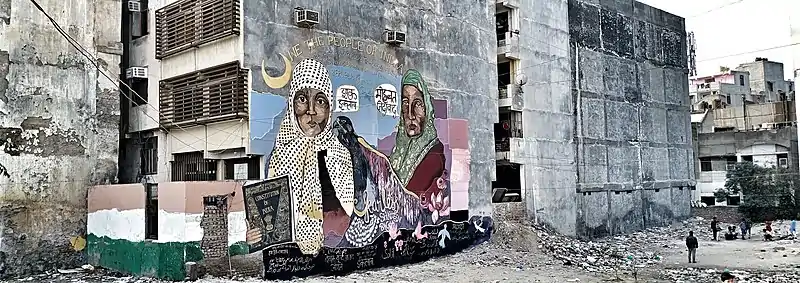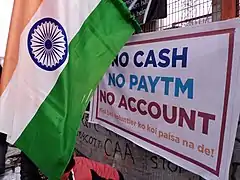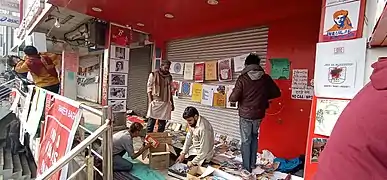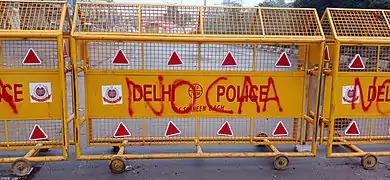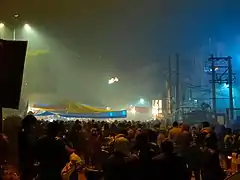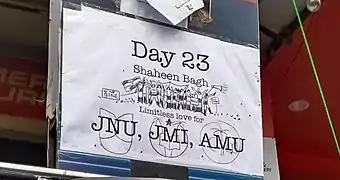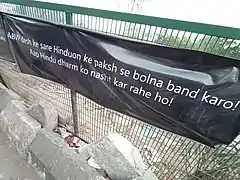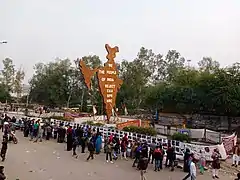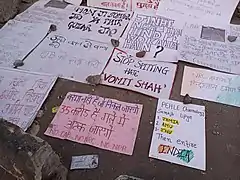Shaheen Bagh Protests
The Shaheen Bagh protest was a sit-in peaceful protest, led by women, that began in response to the passage of the Citizenship (Amendment) Act (CAA) in both houses of the Parliament of India on 11 December 2019 and the ensuing police intervention against students at Jamia Millia Islamia who were opposing the Amendment. Protesters agitated not only against the citizenship issues of the CAA, National Register of Citizens (NRC) and National Population Register (NPR), but also against police brutality, unemployment, poverty and for women's safety. Mainly consisting of Muslim women, the protesters at Shaheen Bagh, since 14 December 2019, blocked a road[lower-alpha 4] in New Delhi using non-violent resistance for 101 days until 24 March 2020. As a precautionary measure Delhi Police barricaded the neighbouring major highways around the area. Following the North East Delhi riots, police barricading and presence in the area increased with over ten companies, 1000 personnel, being assigned to Shaheen Bagh. The protests ended on 24 March 2020 as Delhi Police vacated the site following the COVID-19 pandemic outbreak.
| Shaheen Bagh protests | |||
|---|---|---|---|
| Shaheen Bagh anti-CAA protests Part of Citizenship Amendment Act protests | |||
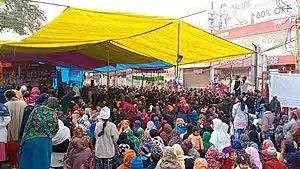 Shaheen Bagh women protesters blocking a major road (Road 13A GD Birla Marg, Shaheen Bagh - Kalindi Kunj area) in New Delhi | |||
| Date |
| ||
| Location | Shaheen Bagh, Delhi, India 28.5513°N 77.2970°E | ||
| Caused by | Passage of the Citizenship (Amendment) Act, 2019 and the following police intervention at Jamia Milia Islamia | ||
| Goals | Pressurize Government to roll back CAA and not to implement NRC-NPR in the country, to revive economy and to take steps on unemployment and women safety | ||
| Methods | Protest, Sit-in, Demonstrations, Civil disobedience, Hunger strike, Slogan, Public lecture, Public debate, Art (Graffiti, Poster, Scale model, Poetry, Storytelling, Street performance, puppetry) | ||
| Status | Halted for lockdown imposed for curbing COVID-19 pandemic in India. Protest did not resume. On 7 October 2020, Supreme Court passed a judgment saying Shaheen Bagh type protests, which occupy public places indefinitely, are not allowed. | ||
| Lead figures | |||
| |||
| Casualties | |||
| Death(s) | 0 [lower-alpha 2] | ||
| Injuries | 1 | ||
| Arrested | 0 [lower-alpha 3] | ||
| Detained | 0 | ||
The leaderless protest became politicized and was generally against the Bharatiya Janata Party (BJP) government. The protesters also supported unions opposing the government's anti-labour policies and protested against recent happenings such as the 2020 JNU Attack, and showed solidarity with Kashmiri Pandits. The barricaded and tented venue drew large crowds; The Wire noted that tens of thousands of protesters participated. The Shaheen Bagh protest also inspired similar Shaheen Bagh-style protests across the country, such as those in Gaya, Kolkata, Prayagraj, Mumbai and Bengaluru.
The blockade became a campaigning issue in the 2020 Delhi Legislative Assembly elections. Some politicians promised to immediately remove the blockade after being voted into power, and were accused by their opponents of prolonging the demonstration to agitate voters. The blocked road affected more than 100,000 vehicles a day, adding hours to some journeys. As the area is also a border point into the capital, thousands of trucks were being diverted to other border points.
Five petitions were filed to stop the blockade. The Delhi High Court refused to hear the first two pleas and on 14 January 2020 declared the blockade to be a police matter. The Delhi Police said that they will not use force to end the blockade. A third petition highlighted the difficulty faced by students with upcoming board examinations. The matter also reached the Supreme Court of India with two pleas being filed. Following the initial hearings, on 17 February the Supreme Court appointed three mediators to initiate conversations with the protesters regarding shifting to a location which doesn't block a public place.
Even after the spread of the coronavirus in India, including additional restrictions enforced by the government under the Epidemic Diseases Act, 1897, which includes a ban on gatherings of more than 50 people and the closure of schools, colleges, cinema halls and weekly markets among other things, the Shaheen Bagh protest still continued for several days. As a precautionary measure the protesters planned a more "controlled gathering" by reducing the number of protesters to just 5 individuals and symbolically placing cots and sandals by other protesters in solidarity. However, following the complete lockdown imposed in Delhi from 23 to 31 March 2020, the remaining few protesters were arrested and forcefully removed from the site by the Delhi Police on 24 March 2020.
In response to the batch of petitions that had been filed against the Shaheen Bagh protestors, the Supreme Court of India gave its judgement on 7 October 2020. The Supreme Court stated that "indefinite" occupation of public space for protest or expressing dissent was not acceptable. One of the Shaheen Bagh protestors, 82-year old Bilkis, was listed in TIME magazines 100 most influential people of 2020 as well as BBC's 100 Women.
Background
Causes

On 12 December 2019, the Parliament of India passed the Citizenship (Amendment) Act, 2019 (CAA), which amends the Citizenship Act of 1955 to grant a swifter path to Indian citizenship under the assumption of religious persecution to any individual belonging to the specific religious minorities of Hindus, Sikhs, Buddhists, Jains, Parsis and Christians from Afghanistan, Bangladesh and Pakistan, for those who entered India on or before 31 December 2014.[6] However, the Act does not mention Muslims and does not offer eligibility benefits to Muslim immigrants or immigrants belonging to other religions or from other countries,[7][8] such as Sri Lankan Tamil refugees,[9][10] Rohingya Muslim and Hindu refugees from Myanmar, and Buddhist refugees from Tibet.[11] It is also alleged that the National Register of Citizens (NRC), which the government plans to implement for the country in 2021, could be used to deprive Muslims of Indian citizenship.[12]
The CAA–NRC issue also ignited protest of the economic crisis and economic disparities that the country is facing.[13][14] Women's safety, rising cost of commodities, increasing unemployment and poverty have acted as catalysts for the protest.[14][15] The Indian economy has been witnessing a decreasing growth rate,[16] increasing household debt,[17] inflation,[18] unemployment[19] and economic inequality.[20] The State Bank of India estimated a growth rate of 4.6% for the financial year (FY) 2020,[21] which would be the lowest since the 2008 Global Recession where the growth rate had been 3.9%.[22] The unemployment rate of India was reported to have reached a 45-year high of 6.1% in FY 2017–18.[23] The Center for Monitoring Indian Economy stated the unemployment rate to be 8.45% with a rate of 37.48% for the 20–24 age group and 12.81% for the 25–29 age group in October 2019.[24] According to the 2019 report of the Pew Research Center, 393.7 million jobs are in a vulnerable state.[25] Oxfam India data states that control of the country's wealth by the richest 1% of the population increased from 58% to 73% between 2018 and 2019, while the wealth of the poorest 50% increased by 1%. The WPS-index (Women, Peace and Security index) ranked India at 133 amongst 167 countries in 2019–20.[26]
The protest

The Shaheen Bagh protest was launched on the afternoon of 14 December 2019, when 10 to 15 local women began to blockade Kalindi Kunj Road (Road 13A[27]), a six-lane highway bordering the Muslim-dominated neighbourhood of Shaheen Bagh in southeast Delhi. More locals joined and it became a continuous sit-in protest.[28][29][30] Many of the women were hijab and burqa wearing Muslim homemakers.[31] Elderly women have also joined the protest,[32][33] and children and newborn babies had been present with their parents.[34][35] The protesters were supported and coordinated by more than a hundred volunteers, including students and professionals from Delhi. These volunteers organized themselves around different tasks: setting up makeshift stages, shelters and bedding; providing food, water, medicine, and access to toilet facilities; installing CCTV cameras and bringing in outside speakers.[36] Within 10 days, the peaceful protest had grown to cover nearly one kilometre (0.5 mi) of the highway, supported by donations.[37] On 2 January 2020, some prominent volunteers withdrew and urged to stop the protest, fearing that its message could be hijacked by political parties with the approach of the Delhi election, which they felt could "tarnish the image of the movement" and raise the risk of violence.[27] However, the women protesters immediately made it clear through social media that they would continue.[38]

With crowds reaching as high as 100,000, the protest became one of the longest sit-in protests of this magnitude in modern India.[28][39] Its stages became a prominent platform to voice issues, and gained support from Punjab farmers.[40][41] A number of protestors cited the 2019 Jamia Milia Islamia (JMI) attack, in which about 200 student protestors were injured by Delhi police at the primarily Muslim JMI university.[42] The protesters also supported unions opposing the government's anti-labour policies.[43] CNN reported that a woman named Bahro Nisa quit her job to continue full-time protest, saying "They tried to stifle the voices of our children [...] as mothers, we decided to stand up".[44] An article in Business Standard called the protest "A new kind of satyagraha [English: civil protest]", noting how a girl was allowed to express her doubts on stage by explaining her dilemma of supporting the CAA while understanding its dangers.[45]
On 31 December 2019, thousands of camping protestors sang the Indian national anthem at midnight,[46][47] on what was reportedly Delhi's second-coldest night in the previous 100 years.[29][48][49] The protest had one of its largest crowds on 12 January 2020.[50] On 26 January, the 71st Republic Day of India, over 100,000 people assembled at the protest site.[51][52] The flag was hoisted by three local elderly women who became known as "Shaheen Bagh dadis" ("grandmother" in Urdu) during the protest and by the mother of Rohith Vemula.[53][54] That day, Umar Khalid and Jigesh Mevani visited the area and delivered their respective speeches.[55] The protesters extended an invitation to the Prime Minister Narendra Modi to come and celebrate the Valentine's Day with heart-shaped cardboard banners.[56] A health camp was also set up beside the camped protesters. Doctors and nurses along with medical students from different medical institutes and hospitals voluntarily joined for the purpose.[57][58] A group of Sikh farmers also came and set up a langer (free community kitchen) in the area.[59]
The barricaded area was visited by numerous politicians such as Indian National Congress (INC) leaders Mani Shankar Aiyar[60] and Shashi Tharoor,[61] social activist Chandrashekhar Azad[62] and celebrities such as Mohammed Zeeshan Ayyub.[47] On 14 February 2020, filmmaker Anurag Kashyap visited Shaheen Bagh and delivered a speech.[63][64] On the same day, the protestors also paid homage to the 40 martyred Central Reserve Police Force personnel in the 2019 Pulwama attack, a suicide bombing attack by terrorists.[65][66] The Union Home Minister Amit Shah sent an open invitation for talks to the elderly Shaheen Bagh protestors.[67] However, a crowd of protestors who marched towards the Union Minister's residence for talks was stopped by the Delhi Police.[68]
Culture
Protest art became the voice of resistance and dissent during the event,[69] and the area was covered in murals, graffiti, posters and banners.[69][70] A number of scale models were installed, including one of a detention camp, depicting those used as a consequence of the NRC in Assam.[71][72] A miniature replica of India Gate bore the names of those killed during the anti-CAA protests across India. Protestors built and erected a 12-metre-high (40 ft) iron welded structure in the shape of India, painted with the message "Hum Bharat ke log CAA-NPR-NRC nahi maante" (English: We the people of India reject CAA-NPR-NRC).[73] Hundreds of paper boats were arranged in the shape of a vast heart facing a small model battle tank; the boats were inscribed with the words of Hum Dekhenge (We will witness), a poem of resistance written by Faiz Ahmad Faiz, with the many small and fragile boats dwarfing the tank which represented state oppression.[74][58] Posters proclaim that the protesters are "a bouquet, not the lotus" (the symbol of the ruling Bharatiya Janata Party [BJP]).[75]
The protest art has been made by anyone, including students from Delhi University, JMI, Jadavpur University and Hyderabad Central University. A reading area called "Read for Revolution" had been set up with hundreds of crowd-sourced books as well as writing materials,[76][77] drawing allusions to the JMI attack in which police allegedly ransacked the university's library and assaulted those inside.[45] On 17 January, a bus stop was converted into the Fatima Sheikh-Savitribai Phule library, which provided material on the country's constitution, revolution, racism, fascism, oppression and various social issues.[78]
Image: Mural at Shaheen Bagh made during the protests
| |||||||||||||||||||||
Speeches, lectures and shayari poetry readings had been held every day (as of 31 December).[79] Lines of poetry and nazm of revolutionary poets such as Faiz Ahmad Faiz, Pash, Habib Jalib, Muhammad Iqbal and Ramdhari Singh Dinkar were recited.[48] Inter-faith prayers have been held.[61][80] Scriptures from the Geeta, the Bible, and the Quran have been read, and Gurbani was held.[61] Many street pedlars came to the site, including balloon vendors and chaatwallas (people cooking chaat from carts), giving the area a "lightness of festivity".[45] Nearby eating establishments in Shaheen Bagh have seen an influx of people with an increase in political conversations, giving them a "taste of revolution".[81]
Between 2 and 8 February 2020, a musical and cultural event called 'Artists Against Communalism' was held in solidarity with anti-CAA protest. Performers included Hindustani classical singer Shubha Mudgal, Carnatic vocalist T. M. Krishna, Sufi singer Madan Gopal Singh, Ankur Tewari (music director of Gully Boy), singer Prateek Kuhad, Kusha Kapila, and Anushka Manchanda,[82][83] and musical groups Advaita, Peter Cat Recording Co., Moongphali and Rajasthani folk troupe Kutle Khan.[84][85] Mudgal performed the song "Hamari Khwaishon ka Naam Inquilab Hain" (English: My dream is my revolution) by poet Gorakh Pandey and "Main nahin janta, main nahin manta" (I refuse to acknowledge, I refuse to accept) by Habib Jalib.[82][86] Rapper Sumit Roy performed his viral rap music "Poorna Swaraj" (Complete freedom) and poet Amir Aziz recited "Main Inkaar Karta Hoon" (I refuse).[82]
— Ghazala, 22, Shaheen Bagh protester[46]
— Nahida Begum, 40, Shaheen Bagh protester[46]
— 70-year-old protester Aasma Khatoon[29]
- Art, graffiti and visuals from the protest site
 Paperboats artwork with Hum Dekhenge poem written on each
Paperboats artwork with Hum Dekhenge poem written on each A miniature tank depicting state oppression resisted by a collection of paperboats arranged in heart shape
A miniature tank depicting state oppression resisted by a collection of paperboats arranged in heart shape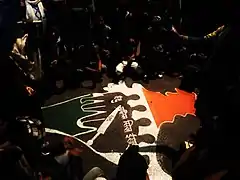 Protesters reciting poetry around a graffito describing RSS trying to break the unity of Hindu-Muslim-Sikh-Isai.
Protesters reciting poetry around a graffito describing RSS trying to break the unity of Hindu-Muslim-Sikh-Isai.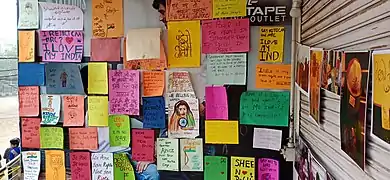 Posters and artwork on a closed storefront
Posters and artwork on a closed storefront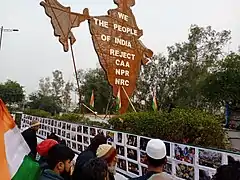 A photo wall by JMI students; in background, a map of India inscribed with a rejection of CAA-NRC-NPR
A photo wall by JMI students; in background, a map of India inscribed with a rejection of CAA-NRC-NPR A graffito of popular rejection and resistance to societal oppression by the CAA-NRC
A graffito of popular rejection and resistance to societal oppression by the CAA-NRC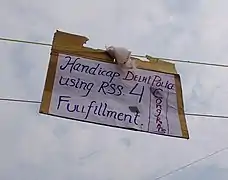 A poster mocking the Delhi Police, connecting it with Hindu paramilitary group Rashtriya Swayamsevak Sangh (RSS).
A poster mocking the Delhi Police, connecting it with Hindu paramilitary group Rashtriya Swayamsevak Sangh (RSS). An India Gate mockup with names of those killed in anti-CAA protests
An India Gate mockup with names of those killed in anti-CAA protests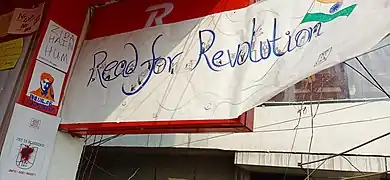 Read for revolution and JNU is Bleeding poster following 2020 JNU Attack[lower-alpha 5]
Read for revolution and JNU is Bleeding poster following 2020 JNU Attack[lower-alpha 5]
Hunger strike
Few protesters were on hunger strike at the Shaheen Bagh. Zainul Abidin, a 29-year-old social activist and businessman from Jamia Nagar, had been on hunger strike since the protest started on 15 December 2019 and continued it into 2020.[87] 50-year-old social activist Mehroneesha began a hunger strike on 1 January 2020.[87] Both stated that they were motivated by police brutality on the students of JMI along with perceived injustices of CAA-NRC.[88] Abidin stated concern for his two sisters who were studying in Jamia, as police reportedly entered the toilets of the institute and beat the female students.[89][90] As of 10 February 2020, no government officials had visited the site or met with these hunger-striking protesters.[91] Reportedly, Abidin was hospitalised and ended a 42-day hunger strike on 26 January 2020.[92]
Children at the protest

Since the first day, children were been present alongside parents who participated in the protest.[93] Most of these children would visit school in the morning before joining their parents at the protest site, which became an art space for many children. They would express their thoughts and join in the protest through storytelling, poetry, puppetry, singing and painting.[94][95] Student volunteers engaged the local children in reading, painting and singing, and held informal reading lessons.[58]
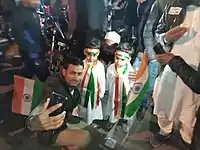
Children drew issues such as the Australian wildfires (with a child writing "Shaheen Bagh prays for Australia") and other things such as Deepika Padukone, Spider-Man and Disney Princesses.[76] Some of the children would go to the stage with slogans such as "Hum kagaz nahin dikhayenge" (we won't show our papers).[76] One of the most common pictures drawn by the children was that of the national flag.[76] Scroll.in called the area an "open air art gallery".[75]
On 21 January 2020, the National Commission for Protection of Child Rights (NCPCR), the top children's-rights body of India, asked authorities to provide counselling for children present at the protests.[96] A complaint was received claiming that the children had been misinformed by their parents about the CAA and detention centers.[97] Children at the site listen to speeches about issues – including CAA-NRC, the Ayodhya dispute, and triple talaq (a.k.a. instant divorce) – which were claimed to have been discriminatory in nature.[98] Some of these children were seen in viral videos of the protests shouting slogans. NDTV reported that the District Magistrate of South East Delhi was informed of claims of "mental trauma" the children may have undergone due to this.[97] After an infant died at the protests the Supreme Court questioned the Union and State governments as to why a four-month year old child was at the protest.[99]
Efforts to remove blockade
Counter-protests against the Shaheen Bagh blockade were held with many locals wanting the roads to reopen.[100][101] The Delhi High Court refused a plea on shifting the protesters from Shaheen Bagh; the bench of the court was presided by the Chief Justice, DN Patel.[102] Another petition was filed by Advocate Amit Sahni "seeking directions to withdraw the closure of Shaheen Bagh stretch" and give Delhi Police the required assistance in addressing the issue.[103] The blocked road affected more than 100,000 vehicles per day,[103] including around 1,800 trucks which are being diverted to other border points.[104]
On 14 January 2020, the Delhi High Court stated that it was a traffic matter to be dealt with by the police according to the larger public interest.[105][106] The Delhi Police then stated that they would look into the restrictions caused by the protesters, which affect tens of thousands of commuters daily, including senior citizens, school children and office workers.[107][108] Delhi Police made a statement saying that they "won't use force to evict protesters from Shaheen Bagh" and would use "persuasion". (Notably, police brutality is among the protesters' grievances.)[109][110] Talks between the protesters and the police failed and the protesters refused to move.[111] The leaderless nature of the protests made it difficult to take any action.[45]
There were various misleading claims by the media related to the incident. One of such claim was that the Delhi High Court ordered police to clear the protest site.[112] The Times of India debunked a viral video which claimed there was a failed police crackdown at Shaheen Bagh; the video was from a CAA protest in East Delhi.[113]
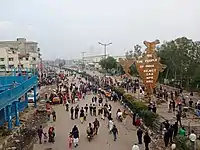
On 17 January 2020, Delhi Lt. Governor Anil Baijal gave the Delhi Police authorization to detain anyone under the National Security Act, for three months beginning on 19 January.[114] This was reportedly clarified by the Home Ministry as a routine order.[114] On 18 January, another petition was filed by Advocate Amresh Mathur on behalf of the Sarita Vihar resident welfare association (RWA) for opening the road, with concerns regarding the upcoming student board exams in February and March. The High Court accordingly directed the police to look into the reasons for the closure.[115]
Delhi BJP chief Manoj Tiwari made a video appeal to the protesters to end the demonstration, noting that the road closure resulted in tens of thousands "completing a 25-minute journey in two-three hours", while stating that the CAA was not against any religion.[116] Protesters responded that they would not budge until CAA is scrapped, but that they will help ease traffic,[117] and said that they have opened the blockade for ambulances and would do so for school buses.[117]
On 21 January, Baijal met a group of eight protesters who submitted a memorandum of demands.[96] On 1 February, Union Minister Ravi Shankar Prasad said that the Narendra Modi government was ready to negotiate in a structured manner.[118][119]
Commentators have noted that the Shaheen Bagh is allowed to continue as it benefits the regime. Pratap Bhanu Mehta noted that, "In Delhi, the protests were allowed to continue in Shaheen Bagh, not because the government was soft. It thought it could use the protest as pretext to consolidate majoritarian sentiment: Look at these minorities blocking roads and standing against Hindu rights, went the refrain."[120]
Police blockades

Scroll.in reported that the effect on traffic congestion was not merely due to the closure of GD Birla Marg, but also because two alternative routes had been barricaded by Delhi and Uttar Pradesh (UP) police. The Quint reported that the protest occupied a small stretch of GD Birla Marg, one of the roads that connects Delhi to Noida, whereas police blocked both the carriage way and the whole road.[121] The first set of barricades were placed ahead of the GD Birla Marg Bridge, but a second set of police barricades were placed 200 metres (660 ft) to the west. This resulted the blockade of Jasola Vihar Main Road and Allama Shiibli Road which could connect Sarita Vihar to Jamia Nagar. Scroll.in could not determine why the police had closed this additional stretch.[122] Delhi Police called this "a security measure". UP Police, on the other hand, blamed the Delhi Police for erecting barricades blocking the entry of commuters from Noida into Delhi, citing the Kalindi Kunj–Mithapur Road blockade. Since Delhi Police blocked the entry point near Kalindi Kunj metro station, UP Police had to block the road on the UP side at Kalindi Kunj Bridge.[122] Delhi Police also blocked the entry of Khadar–Kalindi Kunj Road which connects Jamia Nagar and Noida to Faridabad.[122] Following the North East Delhi riots, police barricading and presence in the area increased with over ten companies (1000 personnel) being deployed in the area.[123]
Petitions in Supreme Court
A plea was filed in the Supreme Court of India requesting supervision of the matter so as to prevent any violence.[124] The plea sought removal of the demonstration, citing that no one can be allowed to occupy a public road under the pretext of peaceful protest and for an indefinite period such that others face inconvenience.[125] Another Supreme Court petition was filed later, on 4 February 2020, by BJP leader Nand Kishore Garg and sought an urgent hearing.[126] On 7 February, the Supreme Court postponed the hearing until after the Delhi elections (scheduled for 8 February), so as not to influence the outcome.[127] On 10 February, in its first hearing, the Court drew the attention of the protesters to the inconvenience caused over months of disruption. The court argued whether protests can be held in common areas indefinitely or if an area should be designated for protests, and considered the consequences of such protests held in public areas everywhere.[128] However, the Court issued notices to the Central Government, the Delhi Government and the Delhi Police, stating that people have the "right to protest" though this couldn't be for "an indefinite period in a common area". The Court did not give any interim order and wanted to hear from the protesters.[129]
On 17 February, the Supreme Court heard the plea, which framed the matter as an issue of protests on public roads. Two interlocutors have been chosen for engagement in dialogues with the protesters by the bench of justices S.K. Kaul and K. M. Joseph and the hearing was scheduled for 24 February 2020. The two interlocutors are senior advocates Sanjay Hegde and Sadhna Ramchandran.[130] The Court also advised the interlocutors that they could seek assistance former Chief Information Commissioner of India, Wajahat Habibullah who filed an affidavit in the Court on the blockade.[131] Habibullah in his affidavit stated the court that the precautionary blockade by police around the protest site is cause for the traffic inconveniences.[132] Hegde and Ramachandran examined the area and had several talk sessions with the protesters. On 24 February 2020, the interlocutors submitted the sealed cover report to the court as the report was only meant to be studied by court.[133][134] The bench received the report to examine the situation and scheduled the hearing for 26 February 2020.[135] However, the Court postponed the hearing for 23 March 2020, following the North East Delhi riots happened between 23 and 26 February 2020.[136] The second round of talks between the interlocutors and the protesters is underway as of 5 March 2020.[137]
Defamation attempts
Kashmiri Pandits' cause
— A 40-year-old female protester at Shaheen Bagh.[138]
On 19 January 2020, the protesters at Shaheen Bagh called for a meeting in solidarity with the Kashmiri Pandits, who were the victims of the exodus in Kashmir.[138] This was observed after a controversial tweet by filmmaker Vivek Agnihotri went viral, claiming that the protesters of Shaheen Bagh would organise an event to celebrate "Kashmiri Hindu Genocide day" on that day, which the official Twitter handle of Shaheen Bagh debunked. A statement was released which clarified that "malicious elements" were circulating false information on social media, and that the event was not to commemorate the exodus.[139] The protesters also recognised the "injustice done" to the Kashmiri Pandits and invited them to the Shaheen Bagh protest site, where they observed a two-minute silence in solidarity. Two prominent Kashmiri Pandits, performance artist Inder Salim and theatre personality M. K. Raina, delivered a speech at the gathering.[140][141]
Paid protest allegations

Photographed, 11 Jan 2020
As the protest entered January, the BJP and its online supporters made claims that protesters were being paid. A doctored poster stating "fix rate RS 500" went viral on social media platforms on 18 January 2020. This claim was debunked when independent website The Logical Indian released a fact check article on the same posters. The article unearthed the veracity of the real poster which says, "CAA wapas lo, NRC wapas lo" (English: Roll back CAA and NRC).[142]
Posters at the site asked participants to not accept any amount of money and to not bribe anyone to participate.[143] On 15 January, Amit Malviya, BJP leader and head of IT cell, tweeted a video which claims that the women protesters had been paid ₹500 to 700 to sit-in.[144] The protest's official Twitter account released a statement and denied the claim.[145]
— Asharfi, a 63-year-old protester.[146]
On 4 February 2020, AltNews and Newslaundry jointly released a fact-checking article in which the veracity of the video was debunked. It was discovered that the video was orchestrated by a shop owner in his shop in Tughlakabad of South Delhi. This demonstrated how the mainstream media's lack of ethical journalism helped to create a false narrative and a negative image of the protest.[147][148]
Two female protesters named Nafisa Bano and Shahzad Fatma sent a defamation notice to Malviya which demanded an apology and ₹1 crore (10 million rupees) in damages from the BJP leader.[145] The notice alleged that the addressees, "have not only played a fraud on the general public but have also attempted to bring disrepute to the protesters".[149] The Quint reported that on 21 January notices had also been sent to Republic TV, Zee News, Times Now, TV18 and News Nation with the same allegations.[150]
Inspiration for other similar protests
The Shaheen Bagh protest inspired several other similar protests in big cities around India. On 7 January 2020, female residents of Park Circus, Kolkata, gathered at Park Circus Maidan to voice their dissent against the CAA. It became one of the most organised protests against CAA-NRC.[151][152] On request from the protesters, the West Bengal state government provided them with tents, bio-toilets, running water and lights so their protest could run continuously.[153] Former Union Minister P. Chidambaram visited the protest and conducted a workshop there on CAA and NRC. Social activist Yogendra Yadav and singer Kabir Suman also visited to extend their support to the protesters.[154]
On 11 January, an all-women sit-in protest started outside Konark Mall in Kondhwa, Pune, organized by Kul Jamaat-e-Tanzeem, an umbrella body of several organisations. This protest started with a few participants and steadily grew a crowd which reached around 500–600 protesters on 19 January. According to a protester the movement was to save the constitution and the country. Candle light vigils, human chains and speeches were part of the protest. The venue had banners with slogans such as "Tumhari Lathi Se Tej Hamari Awaaz Hai" (English: Our voice is louder than your batons) and "India Needs Education, Jobs, Not CAA, NRC, NPR".[155]
On 12 January, a group of women started a CAA sit-in demonstration in the market area of Patna's Sabzibagh. Over the following three days, people of all ages gathered to join them in the protest.[156] Also on 12 January, inspired by the women of Shaheen Bagh, groups of ten women began sit-in protests at the Mansoor Ali Park of Roshan Bagh, Allahabad.[157][158] Over the next few days, thousands of women, students, and others sat through the rain and cold to join the resistance against the CAA–NRC through slogans, speeches and poems.[159][160]
Similar protests were held at Kanpur's Chaman Ganj, Gaya's Shanti Bagh,[161][162] Kota's Eidgah ground,[163] Lucknow's Clock Tower[164] and Fraser Town in Bangalore.[165] Inspired by the Shaheen Bagh protest, a large anti-CAA-NRC-NPR protest started in Mumbai on 17 January. Around 10,000 women gathered in the evening at the YMCA ground in Mumbai to protest. The protest was organised by NGO collective Mumbai Citizen Quorum.[166][167] On 20 January, an indefinite sit-in protest started at Parbhani, called "Parbhani bhi ek Shaheen Bagh", which was organised by Samvidhan Bachao Tahrik.[168][169] Protests were also held in Bilal Bagh, Bengaluru, Karnataka;[170] Nagpada,[171][172] YMCA ground, Agripada,[166][173] Mumbai, Maharashtra; Anaj Mandi, Malerkotla, Punjab;[174] Haj House, Ranchi, Jharkhand;[175][176][177] Idgah ground, Deoband,[178] and Mansoor Ali Park, Prayagraj[179][180] Uttar Pradesh; Old Washermanpet, Chennai, Tamil Nadu;[181][182] and Jaffrabad, Delhi.[183]
After on-street protestors were evacuated, the women of Shaheen Bagh became active on the social media. In March 2020, when the Kabul gurdwara attack took place, they posted a solidarity note on their Twitter account:
We, the women of #ShaheenBaghs all over India, strongly condemn the brutal terrorist attack on the Gurudwara in Kabul. We stand in strong solidarity with our #Sikh sisters and brothers who have been a shining beacon of hope in hard times across country, race, caste and creed.[184]
While BJP leaders like Kapil Mishra and many from the social media taunted the Sikhs in India, linking the Kabul gurdwara attack incident as thankless reciprocation for the humanitarian efforts of the Sikh community, especially their extra-ordinary support extended during the 101-day long historic anti-CAA-NRC-NPR protest at Shaheen Bagh in New Delhi, many community members responded saying: "Sikhs will continue to stand for victims and will continue providing Langar to the needy, even if ISIL or someone else is behind this attack. For us, Hindus and Muslims are human first." [185]
This protest shared many similarities with the 2020–2021 farmers protest at Delhi as well as it was also referred to as the inspiration for the later protest in terms of the spontaneous nature, apprehension of being victimized through legislation, ability to spread across many fronts, drawing national and international reactions, centerstaging the role of women, being a bannerless agitation and both protests garnering support from anti-BJP quarters. [186]
Delhi Assembly election issue
The blockade at Shaheen Bagh became a campaign issue for the Delhi Legislative Assembly election, held on 8 February 2020.[187] Chief Minister of Delhi Arvind Kejriwal Aam Aadmi Party (AAP) and Home Minister of India Amit Shah criticized each other over their positions on the protest. On 27 January, during an election rally, Shah said that the protesters would not listen to the BJP government regarding the removal of the road block. Shah asked Kejriwal whether "he is with the people of Shaheen Bagh or not" as some AAP members had publicly sided with the protesters. Kejriwal accused the BJP of using "dirty politics" and prolonging the road closures to cause a public backlash against the protesters, and noted their promises to reopen the route following the election meant that they could do so at any time. He urged the BJP leadership to visit Shaheen Bagh, talk with the protesters, and open the blockade.[188][189]
Union Law Minister Ravi Shankar Prasad (BJP) said that Shaheen Bagh was offering a platform for the "anti-India" gangs.[190] Junior finance minister Parvesh Verma (BJP) made hateful and abusive comments about the Shaheen Bagh protesters and claimed that they would be cleared within an hour of the election results being declared on 11 February.[191] Verma was later penalised by the Election Commission and BJP for his comments.[192] Several other BJP leaders made statements regarding removal of the protesters from Shaheen Bagh. One said that a "surgical strike" would be conducted on the protesters on 11 February.[193] Hindu Sena stated that they would remove all "Shaheen Bagh Jihadis" at 11 am on 2 February.[194] This plan was cancelled after consultations with the Delhi Police.[195]
Threats to the protesters
Several BJP leaders and politicians made hate speeches against the protesters, including Yogi Adityanath, Anurag Thakur and Parvesh Verma.[196][197] This was followed by attempts to threaten the protesters. On 28 January 2020, an armed man entered the Shaheen Bagh protest site, climbed the stage, and threatened people to stop the agitation; he was later overpowered by protesters.[198]
On 1 February, a Hindu fundamentalist entered the barricaded area and fired a gun three times into the air near the stage. He shouted the slogan Jai Shree Ram and said no one other than Hindus will have a say in this country;[199][200][201] he was taken into police custody and later released on bail.[202][203] The incident happened two days after a Hindu fundamentalist shot and injured a student protester in the presence of police near Jamia Millia Islamia.[204][205] The alleged perpetrator of the Jamia incident had made various threatening and hateful social media posts, including one in which he threatened to convert "Shaheen Bagh into Jallianwala Bagh", the site of a massacre.[206] On 2 February 2020, the Election Commission of India transferred Chinmoy Biswal, the then deputy commissioner of police (DCP) for South East Delhi, citing the multiple shooting incidents in the Jamia area, which was an election polling area.[207]
Impact of coronavirus pandemic
Following the spread of the coronavirus in India in 2020, the Press Trust of India reported that the women at Shaheen Bagh had said that "the protesters were being provided with masks and hand sanitisers and there was no need to be scared."[208] However, the Chief Minister of Delhi made it clear that restrictions were in place in Delhi as per the Epidemic Diseases Act, 1897 and this applied to protests too. Schools, colleges, malls, weekly markets, cinema halls and gatherings of more than 50 people had been banned in Delhi.[208] The Chief Minister made it clear that those who did not comply with the Act would be punished.[209] However, the coordinators stated that "the order of shut down has come for entertainment services, while Shaheen Bagh is agitation and fight for survival" and that only a Supreme Court order could get them to move.[210] As a precautionary measure the protesters planned for a "controlled gathering".[211]
The protest followed the "Janata Curfew", a self-imposed curfew announced by the Prime Minister Narendra Modi on 22 March 2020,[212] by reducing the number of protesters to 5 and symbolically leaving behind cots and sandals by other protesters at the site in solidarity.[4] However, a complete lockdown was imposed in Delhi by Chief Minister Arvind Kejriwal from 23 to 31 March 2020, following which the protesters were removed by the Delhi police on 24 March 2020, 101 days after the start of the protest.[1][213] It was reported that the police arrested the remaining few protesters who were present there as they refused to end the protest and leave the site.[1][214][215]
Aftermath
In response to a petition filed by advocate Amit Sahni in February in the Supreme Court seeking lifting of the blockade due to the Shaheen Bagh protests, Justices Sanjay Kishan Kaul, Aniruddha Bose and Krishna Murari concluded on 7 October 2020 that "such kind of occupation of public ways, whether at the site in question or anywhere else for protests is not acceptable and the administration ought to take action to keep the areas clear of encroachments or obstructions".[216][217] The Supreme Court stated on a batch of petitions against Shaheen Bagh that "indefinite" occupation of public space for protest or expressing dissent was not acceptable.[218][219]
Bilkis Dadi, one of the "Dadis of Shaheen Bagh" (English: Grandmothers of Shaheen Bagh), was included by TIME magazine in its list of "The 100 Most Influential People of 2020".[220][221] In a statement to Indian Express in October 2020, she said "Nobody here talks about the protest or is willing to talk about it anymore. They’re scared."[222] All that remains at the protest site is graffiti.[222] On 23 November 2020, Bilkis was also listed in BBC's 100 Women list.[223] On 30 December, the Hindu fundamentalist shooter, who was temporarily detained for firing at the Shaheen Bagh protest site, officially joined the Bharatiya Janata Party.[199][202] After a few hours when the news of his joining the party broke out, he was expelled from the party.[224]
Gallery
See also
- Irom Chanu Sharmila
- 2020 Women's March
- 2019–20 French pension reform strike
- Yellow vests movement
- No NRC Movement.
Footnotes
- Media coordinator of Shaheen Bagh Protest: Qazi Emad[2]
- A four month old child's parents told media that their child died in sleep in their tiny plastic shanty. It was reported that the child caught cold and congestion after got exposed during the winter chill as the mother was attending the outdoor protest.[3]
- As a precautionary measure for the Coronavirus pandemic, the protesters reduced the number of protesters at the site to just 5 individuals.[4] As complete lockdown was imposed in Delhi from 23 to 31 March 2020,[5] the Delhi Police tried to remove the protesters from the site and on refusal by the police, the protesters who were present (assumed to be 5) were arrested on 24 March 2020.[1]
- Road No 13-A, Shaheen Bagh (GD Birla Marg) - Mathura Road - Kalindi Kunj - Shaheen Bagh stretch is a border point that connects New Delhi to Noida and Faridabad.
- The library and reading area is symbolic and a protest "against the violent ransacking of the Jamia library and beating up of its readers by the Delhi Police."[45]
References
- Bhasin, Swati (24 March 2020). "Shaheen Bagh Anti-CAA Protesters Removed Amid Delhi Lockdown". NDTV. Retrieved 24 March 2020.
- "Shaheen Bagh protesters will have to follow ban on gathering over coronavirus: Kejriwal". Hindustan Times. 16 March 2020. Retrieved 19 March 2020.
- "Infant dies after catching cold at Shaheen Bagh, mother to return for anti-CAA protest". The India Today. 3 February 2020. Retrieved 16 February 2020.
- "As Shaheen Bagh Sticks to 5 Protester Limit, Vigilante Attacks Site With Petrol Bomb". The Wire. 22 March 2020. Retrieved 24 March 2020.
- "Coronavirus Fallout: Delhi CM Arvind Kejriwal announces lockdown until March 31". The Times of India. 23 March 2020. Retrieved 24 March 2020.
- "Parliament passes the Citizenship (Amendment) Bill 2019". Press Information Bureau, Government of India. 11 December 2020. Retrieved 9 October 2020.
- Jaffrelot, Christophe; Laliwala, Sharik (12 December 2019). "Citizenship law, proposed nation-wide NRC will revise conception of group rights in India". The Indian Express. Retrieved 9 October 2020.
Indeed, the CAB would only apply to undocumented Hindus, Sikhs, [...] would become "refugees" whereas Muslims and members of other minorities, or atheists, would remain illegal.
- Dowerah, Simantik (11 December 2019). "Rajya Sabha passes Citizenship Amendment Bill: What is a Hindu and why are Myanmar, Nepal, Bhutan, Sri Lanka left out of CAB?". MSN. Firstpost. Retrieved 16 December 2019.
- Shaji, K.A (23 December 2019). "CAA: Sri Lankan Tamil Refugees Say The New Law Has Killed Their Hopes Of Citizenship". The Huffington Post. Retrieved 28 December 2019.
- "Missing from India's citizenship law: 100,000 Sri Lankan refugees". Malay Mail. Thomson Reuters Foundation. 28 December 2019. Retrieved 28 December 2019.
- Chaudhry, Suparna (13 December 2019). "India's new law may leave millions of Muslims without citizenship". Washington Post. Retrieved 18 December 2019.
- Nath, Akshaya (20 December 2019). "Protests continue in Tamil Nadu against CAA, NRC". India Today. Retrieved 22 December 2019.
- Chandra, Abhimanyu (23 December 2019). "All Modi-Shah are doing, not just CAA and NRC, is to polarise on communal lines: Yashwant Sinha". The Caravan. Retrieved 15 January 2020.
- Venugopal, Vasudha (4 February 2020). "Not bothered who wins Delhi elections, say Shaheen Bagh protesters". The Economic Times. Retrieved 5 February 2020.
- Pal, Sumedha (4 February 2020). "Delhi Elections: At Shaheen Bagh, Youths Erect 'Unemployment Mirror of India'". Newsclick.in. Retrieved 5 February 2020.
- Raghu, S. A. (14 December 2019). "Underlying causes of the economic slowdown". The Hindu Business Line. Retrieved 15 January 2020.
- Bhardwaj, Sameer (28 January 2019). "Indian households' debt doubles in FY17-18: What are we borrowing for and how much?". The Economic Times. Retrieved 15 January 2020.
- Mishra, Asit Ranjan (14 January 2020). "Inflation shock after GDP growth slump". Livemint. Retrieved 15 January 2020.
- Sharma, Manoj, ed. (1 November 2019). "India's unemployment rate rises to 3-year high of 8.5% in October: CMIE". Business Today. Retrieved 15 January 2020.
- "Why India needs to get over growth numbers, and look beyond". The Economic Times. 24 December 2019. Retrieved 15 January 2020.
- "SBI lowers GDP estimates for FY20 to 4.6% from 5%- Business News". Business Today. 9 January 2020. Retrieved 15 January 2020.
- "Report for Selected Countries and Subjects". International Monetary Fund. Retrieved 15 January 2020.
- Jha, Somesh (31 January 2019). "Unemployment rate at four-decade high of 6.1% in 2017-18: NSSO survey". Business Standard India. Retrieved 15 January 2020.
- Kaul, Vivek (20 November 2019). "Easynomics: What does the government have to do with India's unemployment problem?". Bangalore Mirror. Retrieved 15 January 2020.
- Devlin, Kat (25 March 2019). "A Sampling of Public Opinion in India". Pew Research Center. Retrieved 15 January 2020.
- Georgetown Institute for Women, Peace and Security and Peace Research Institute Oslo. 2019. Women, Peace and Security Index 2019/20: Tracking sustainable peace through inclusion, justice, and security for women. Washington, DC: GIWPS and PRIO. ISBN 978-0-578-53109-0
- Sarfaraz, Kainat (2 January 2020). "Shaheen Bagh protest organiser calls it off, can't get people to vacate". The Hindustan Times. Retrieved 8 February 2020.
- PTI (26 December 2019). "Unfazed by cold, 200 women stage sit-in at Shaheen Bagh, police seek to end protest". India Today. Archived from the original on 26 December 2019. Retrieved 13 January 2020.
- "Shaheen Bagh: The women occupying Delhi street against citizenship law - 'I don't want to die proving I am Indian'". BBC. 4 January 2020. Archived from the original on 8 January 2020. Retrieved 13 January 2020.
- Reporter, Staff (29 December 2019). "Shaheen Bagh residents brave the cold as anti-CAA stir enters Day 15". The Hindu. ISSN 0971-751X. Archived from the original on 13 January 2020. Retrieved 13 January 2020.
- Kuchay, Bilal (15 January 2020). "Shaheen Bagh protesters pledge to fight, seek rollback of CAA law". Al Jazeera. Archived from the original on 15 January 2020. Retrieved 15 January 2020.
- Badhwar, Natasha (17 January 2020). "Speaking truth to power, in Shaheen Bagh and beyond". The Livemint. Retrieved 23 January 2020.
- Petersen, Hannah Ellis; Azizur Rahman, Shaikh (21 January 2020). "'Modi is afraid': women take lead in India's citizenship protests". The Guardian. Retrieved 23 January 2020.
- Salam, Ziya Us (31 January 2020). "CAA protests: Making it count in Delhi". The Frontline. The Hindu. Retrieved 4 February 2020.
- Saaliq, Sheikh (24 January 2020). "Muslim women occupy streets in India against citizenship law". AP NEWS. Retrieved 9 October 2020.
- "The volunteers of Shaheen Bagh". The Telegraph (Calcutta). Reuters. 24 December 2019. Retrieved 8 February 2020.
- "Shaheen Bagh sit-in: How Muslim women have taken the lead at Delhi CAA protest". India Today. Living Media India. Reuters. 25 December 2019. Retrieved 8 February 2020.
- "Organiser 'Calls Off' Shaheen Bagh Anti-CAA Protest, Locals Continue Dharna". The Wire. 2 January 2020. Retrieved 8 February 2020.
- "Watch | Women, Homemakers Lead Protests Against CAA at Delhi's Shaheen Bagh". The Wire. 20 December 2019. Archived from the original on 12 January 2020. Retrieved 13 January 2020.
- "Sikh Farmers from Punjab Join as Anti-CAA, NRC Stir at Shaheen Bagh Enters Second Month". News18. PTI. 15 January 2020. Retrieved 5 February 2020.
- Kamal, Neel (4 February 2020). "Mansa farmers join Shaheen Bagh stir". The Times of India. Retrieved 5 February 2020.
- Slater, Joanna; Masih, Niha (17 December 2019). "Protests erupt across India against new citizenship law after police storm university campus". Washington Post. Retrieved 16 December 2019.
- "CAA protest enters 27th day at Jamia, Shaheen Bagh". The New Indian Express. Archived from the original on 13 January 2020. Retrieved 13 January 2020.
- Swati, Gupta; Manveena, Suri; Julia, Hollingsworth (15 January 2020). "The women who have occupied a New Delhi street for a month". CNN. Archived from the original on 15 January 2020. Retrieved 15 January 2020.
- Datta, Pradip Kumar (16 January 2020). "Shaheen Bagh: A new kind of 'satyagraha' with a fresh grammar of protest". Business Standard India. Retrieved 18 January 2020.
- Kapur, Manavi (3 January 2020). "At a women-led protest site in India, Muslims navigate identity, hope, and despair". Quartz India. Archived from the original on 13 January 2020. Retrieved 13 January 2020.
- Abbas, Zafar (31 December 2019). "Celebrities, activists join protesters at Shaheen Bagh to celebrate New Year". Millennium Post. Archived from the original on 13 January 2020. Retrieved 13 January 2020.
- Bakshi, Asmita (2 January 2020). "Portraits of resilience: the new year in Shaheen Bagh". Livemint. Archived from the original on 13 January 2020. Retrieved 13 January 2020.
- Dwivedi, Sukirti (1 January 2020). Achom, Debanish (ed.). "Protesters Usher In New Year At Delhi's Shaheen Bagh With National Anthem". NDTV. Archived from the original on 2 January 2020. Retrieved 13 January 2020.
- Sarfaraz, Kainat (13 January 2020). "Biggest crowd at Shaheen Bagh since protest began 4 weeks ago". Hindustan Times. Archived from the original on 13 January 2020. Retrieved 13 January 2020.
- "Amid Anti-CAA Protests, Thousands Join Flag Hoisting At Shaheen Bagh on Republic Day". The Quint. 26 January 2020. Retrieved 3 February 2020.
- Gandhiok, Jasjeev (27 January 2020). "Away from Rajpath, Shaheen Bagh 'celebrates the Republic'". The Times of India. Retrieved 3 February 2020.
- "CAA protesters celebrate Republic Day all across India in their own unique way". The India Today. 27 January 2020. Retrieved 3 February 2020.
- "In Photos: Republic Day at Shaheen Bagh". The Wire. 27 January 2020. Retrieved 3 February 2020.
- Kuchay, Bilal (26 January 2020). "'Fight for India's soul': Protests mark Republic Day celebrations". AlJazeera. Retrieved 26 January 2020.
- "Shaheen Bagh Protesters' Valentine's Day Invitation To PM Narendra Modi". NDTV. 14 February 2020. Retrieved 9 October 2020.
- "At Shaheen Bagh anti-CAA stir, protesters brave biting cold 24x7". Hindustan Times. 29 December 2020. Archived from the original on 13 January 2020. Retrieved 13 January 2020.
- "Behind Shaheen Bagh's Women, An Army of Students, Doctors & Locals". The Quint. YouTube. 14 January 2020. Retrieved 14 February 2020.
- Rawat, Gargi (15 January 2020). Sanyal, Anindita (ed.). "Sikh Farmers From Punjab Come To Cheer Shaheen Bagh Women, Cook Langar". NDTV. Archived from the original on 15 January 2020. Retrieved 15 January 2020.
- "Mani Shankar Aiyar addresses protestors at Shaheen Bagh, makes contentious remarks". The Times of India. ANI. 15 January 2020. Retrieved 15 January 2020.
- "Anti-CAA stir: Inter-faith prayer to uphold values of Preamble as Shaheen Bagh protest nears month". The New Indian Express. PTI. 13 January 2020. Archived from the original on 13 January 2020. Retrieved 13 January 2020.CS1 maint: others (link)
- Shukla, Saurabh (23 January 2020). ""Women Fighting For India": Chandrashekhar Azad's Message At Shaheen Bagh". NDTV. Retrieved 23 January 2020.
- "Shaheen Bagh Protesters Pay Homage to Pulwama Martyrs, Anurag Kashyap Chips In". The News18. 14 February 2020. Retrieved 14 February 2020.
- "Shaheen Bagh too pays homage to the Pulwama martyrs". The NDTV India. YouTube. 14 February 2020. Retrieved 14 February 2020.
- "Shaheen Bagh protestors pay tribute to Pulwama martyrs". The Times Now. YouTube. 14 February 2020. Retrieved 14 February 2020.
- "Shaheen Bagh protestors pay homage to Pulwama martyrs, Anurag Kashyap chips in". The Outlook. 14 February 2020. Retrieved 14 February 2020.
- Is Amit Shah scared of Shaheen Bagh Dadis?
- "Shaheen Bagh protesters march to meet Amit Shah, stopped by police". The Times of India. ANI. 16 February 2020. Retrieved 9 October 2020.CS1 maint: others (link)
- Venkataramakrishnan, Rohan. "The Art of Resistance: Ringing in the new year with CAA protesters at Delhi's Shaheen Bagh". Scroll.in. Archived from the original on 6 January 2020. Retrieved 13 January 2020.
- Bakshi, Asmita (10 January 2020). "The old guard: meet the elderly protesters of Zakir Nagar and Shaheen Bagh". Livemint. Archived from the original on 13 January 2020. Retrieved 13 January 2020.
- Mukhaerjee, Paroma (30 January 2020). "Shaheen Bagh's revolution highway". The Live Mint. Retrieved 4 February 2020.
- "NRC and story of how Assam got detention centres for foreigners". The India Today. 27 December 2019. Retrieved 4 February 2020.
- Beg, Sahil M (18 January 2020). "The colourful dissent: When Shaheen Bagh, Jamia become a canvas for protest". The Indian Express. Retrieved 18 January 2020.
- Kataria, Meenu (13 January 2020). "Different Faiths, One Voice: How Shaheen Bagh Protests Captured India's True Spirit Of 'Oneness'". The Scoop Whoop. Retrieved 4 February 2020.
- Staff, Scroll (23 January 2020). "The Art of Resistance: Delhi's Shaheen Bagh has turned into an open air art gallery". Scroll.in. Retrieved 26 January 2020.
- Ajmal, Anam (11 January 2020). "Delhi: Shaheen Bagh juniors draw attention to CAA | Delhi News - Times of India". The Times of India. Archived from the original on 12 January 2020. Retrieved 13 January 2020.
- Thakur, Jyoti (11 January 2020). "Shaheen Bagh Kids and Jamia Students Make Space for Art, Reading and Revolution". The Citizen. Archived from the original on 13 January 2020. Retrieved 13 January 2020.
- Ameen, Furquan (20 January 2020). "The Library at Shaheen Bagh". The Telegraph (Cacutta). Retrieved 23 January 2020.
- Chakrabarti, Samrat (31 December 2019). "Shaheen Bagh Heralds a New Year With Songs of Azaadi". The Wire. Archived from the original on 1 January 2020. Retrieved 13 January 2020.
- Roy, Divyanshu Dutta (13 January 2020). "Massive Crowd, Multi-Faith Prayer At CAA Protest In Delhi's Shaheen Bagh". NDTV. Archived from the original on 13 January 2020. Retrieved 13 January 2020.
- Ramani, Priya (30 January 2020). "Adda and lemon tea at Shaheen Bagh". Livemint. Retrieved 30 January 2020.
- Das, Aritry (7 February 2020). "Shubha Mudgal To Rapper Sumit Roy: When A Common Cause Makes Them Perform At Shaheen Bagh". The Outlook India. Retrieved 9 February 2020.
- "Prateek Kuhad and many other artists perform in Shaheen Bagh in solidarity with anti-CAA protest". The National Herald (India). 6 February 2020. Retrieved 9 February 2020.
- "Stars and Artists Line Up for Spontaneous Festival at Shaheen Bagh". The Wire. Retrieved 4 February 2020.
- "Prateek Kuhad Singing at the Shaheen Bagh Protest was Solidarity, Not a Free Concert". News18. Retrieved 6 February 2020.
- "Watch: Singer Shubha Mudgal joins CAA protest at Shaheen Bagh, sings Habib Jalib's 'Dastur'". The Scroll. 7 February 2020. Retrieved 9 February 2020.
- Kaur, Pawanjyot; Dhoundiyal, Brijmohan (15 January 2020). "Meet the Anti-CAA Protesters On Hunger Strike at Shaheen Bagh". The WIre. Retrieved 10 February 2020.
- "Meet the Two Protestors on Hunger Strike Against CAA". The Wire. YouTube. 14 January 2020. Retrieved 10 February 2020.
- "Jamia ground report: Police entered mosque, beat up imam and me, claims former armyman". The India Today. 17 December 2019. Retrieved 10 February 2020.
- "'Cops Entered Bathrooms, Libraries and Beat up Girls': Jamia Students Recount Sunday Night Horror". The News18. 16 December 2019. Retrieved 10 February 2020.
- Vincent, Pheroz (13 January 2020). "Shaheen soldiers on". The Telegraph (Calcutta). Retrieved 10 February 2020.
- "Delhi Congress President Subhash Chopra meets man on hunger strike at Shaheen Bagh". The Business Standard. 26 January 2020. Retrieved 10 February 2020.
- "Tea, biryani, national anthem: How anti-CAA protesters in Shaheen Bagh welcomed 2020". The Hindustan Times. 1 January 2020. Retrieved 22 January 2020.
- "Shaheen Bagh protests in pictures: Graffiti, demonstrations on display against Citizenship Act, NRC". India TV. 13 January 2020. Retrieved 22 January 2020.
- Purkait, Aishik (22 January 2020). "In Shaheen Bagh, Children Paint Their Protest while Mothers Hold Dharna". Makers India. Retrieved 22 January 2020.
- "Delhi Lieutenant Governor Meets Shaheen Bagh Protesters, Calls For Peace". NDTV. PTI. 21 January 2020. Retrieved 22 January 2020.CS1 maint: others (link)
- Roy, Divyanshu Dutta (22 January 2020). "Rights Body Flags Shaheen Bagh Protest Over "Mental Trauma" To Children". NDTV. Retrieved 22 January 2020.
- Venugopal, Vasudha (22 January 2020). "On eve of SC hearing, Shaheen Bagh women fast, write postcards to CJI". The Economic Times. Retrieved 24 January 2020.
- Pai, Nitin (11 February 2020). "Supreme Court can't care for Shaheen Bagh children more than the parents". ThePrint. Retrieved 5 March 2020.
- Yadav, Ankit (13 January 2020). "Protest against Shaheen Bagh Anti CAA protests, locals want stir to end in 48 hrs". India Today. Archived from the original on 13 January 2020. Retrieved 13 January 2020.
- "Protesters Chanting 'Jai Shri Ram' Stage Demonstration Near Shaheen Bagh". The Wire. 2 February 2020. Retrieved 4 February 2020.
- "HC turns down plea on shifting protesters from Shaheen Bagh". India Today. 10 January 2020. Archived from the original on 11 January 2020. Retrieved 13 January 2020.
- Tripathi, Karan (13 January 2020). "Shaheen Bagh Protests: Plea In Delhi HC Seeks Reopening Of Stretch Closed Due To Anti-CAA Stir". Live Law. Archived from the original on 13 January 2020. Retrieved 13 January 2020.
- Paras, Singh (16 January 2020). "Delhi: Shaheen Bagh takes toll on other border points". The Times of India. Retrieved 16 January 2020.
- "Shaheen Bagh protest: HC asks Delhi Police to review traffic restrictions". The Indian Express. 14 January 2020. Archived from the original on 14 January 2020. Retrieved 14 January 2020.
- "Delhi HC directs police to look into restrictions on Kalindi Kunj-Shaheen Bagh stretch". India Today. 14 January 2020. Archived from the original on 14 January 2020. Retrieved 14 January 2020.
- "Delhi HC directs police to look into restrictions on Shaheen Bagh stretch". Hindustan Times. 14 January 2014. Archived from the original on 14 January 2020. Retrieved 14 January 2020.
- "Delhi High Court dismisses plea seeking to open Kalindi Kunj-Shaheen Bagh stretch, says police's responsibility to manage traffic". Firstpost. 14 January 2020. Archived from the original on 14 January 2020. Retrieved 14 January 2020.
- Sharma, Neeta (14 January 2020). "Delhi Cops Told To Use "Persuasion" To End Shaheen Bagh Blockade: Sources". NDTV. Archived from the original on 14 January 2020. Retrieved 14 January 2020.
- Pandey, Munish Chandra (14 January 2020). "Won't use force to evict protestors from Shaheen Bagh: Delhi Police after court order". India Today. Archived from the original on 14 January 2020. Retrieved 14 January 2020.
- Sharma, Milan (16 January 2020). "Talks between Delhi Police and anti-CAA protesters at Shaheen Bagh fail, women refuse to move". India Today. Retrieved 18 January 2020.
- Daniyal, Shoaib. "Fact Check: Delhi High Court did not order police to clear Shaheen Bagh protest". Scroll.in. Archived from the original on 14 January 2020. Retrieved 15 January 2020.
- Times Fact Check (17 January 2020). "FACT CHECK: No police 'crackdown' at Shaheen Bagh protest site". The Times of India. Retrieved 18 January 2020.
- "Days after HC order on Shaheen Bagh protests, LG empowers Delhi CP to detain anyone for next 3 months". Business Today. 17 January 2020. Retrieved 18 January 2020.
- "Delhi HC directs police to look into Kalindi Kunj-Shaheen Bagh blockage causing difficulty for students". The Economic Times. ANI. 18 January 2020. Retrieved 19 January 2020.
- Bhasin, Swati, ed. (15 January 2020). "Delhi BJP's Manoj Tiwari's Video Appeal To CAA Protesters At Shaheen Bagh". NDTV. Archived from the original on 15 January 2020. Retrieved 15 January 2020.
- Khan, Fatima (14 January 2020). "Will help ease traffic but won't move, say Delhi's Shaheen Bagh CAA protesters after HC order". ThePrint. Archived from the original on 15 January 2020. Retrieved 15 January 2020.
- PTI (1 February 2020). "Ravi Shankar Prasad: Centre ready to talk to Shaheen Bagh protesters but in a structured form". The Times of India. Retrieved 3 February 2020.
- "Talks With Shaheen Bagh Protesters Must Be in Structured Form: Ravi Shankar Prasad". The Wire. Retrieved 3 February 2020.
- Mehta, Pratap Bhanu (29 February 2020). "The Delhi darkness: Our rulers want an India that thrives on cruelty, fear, division, violence". The Indian Express. Retrieved 6 March 2020.
- "Traffic Inconvenience Vs Human Rights: Why Shaheen Bagh Must Stand". The Quint. 17 January 2020. Retrieved 15 February 2020.
- Lalwani, Vijayta (10 February 2020). "Why have Delhi and UP Police blocked alternative routes around Shaheen Bagh?". The Scroll.in. Retrieved 10 February 2020.
- Das, Shaswati (1 March 2020). "Heavy security, Section 144 in Delhi's Shaheen Bagh after northeast violence". Livemint. Retrieved 5 March 2020.
- "Plea in Supreme Court over traffic blockade in Delhi's Shaheen Bagh". Hindustan Times. 20 January 2020. Retrieved 23 January 2020 – via Press Trust of India.
- Rajagopal, Krishnadas (7 February 2020). "SC to hear pleas against protest at Shaheen Bagh on February 10". The Hindu. Retrieved 10 February 2020.
- PTI. "BJP leader seeks urgent SC hearing for removal of Shaheen Bagh protesters". The Hindu BusinessLine. Retrieved 4 February 2020.
- Vaidyanathan, A (7 February 2020). Srinivasan, Chandrashekar (ed.). "'Cat Out Of Bag': Top Court To Hear Shaheen Bagh Case After Delhi Polls". NDTV. Retrieved 7 February 2020.
- Rajagopal, Krishnadas (10 February 2010). "Shaheen Bagh closure: There cannot be indefinite protest in common area, says SC". The Hindu. Retrieved 10 February 2020.
- Vaidyanathan, A; Ghosh, Deepshikha (10 February 2020). "Can't Block Public Road Indefinitely: Top Court On Shaheen Bagh Protest". NDTV. Retrieved 10 February 2020.
- Pallwal, Aishwarya (22 February 2020). "Shaheen Bagh kayam rahe, only here to talk about roads: Sadhana Ramachandran on Day 4 of mediation". The India Today. Retrieved 25 February 2020.
- "Shaheen Bagh mediator tells SC protest peaceful, police block roads". The India Today. 23 February 2020. Retrieved 25 February 2020.
- "Delhi Police, Not Protestors, to Blame for Traffic Around Shaheen Bagh: Ex CIC Tells SC". The Wire. 23 February 2020. Retrieved 25 February 2020.
- Mahajan, Shruti (24 February 2020). "Shaheen Bagh Protests: Interlocutors hand over report to Supreme Court in sealed cover". The Bar and Bench. Retrieved 25 February 2020.
- "Supreme Court: Interlocutors Submit 'Sealed Cover' Report on Shaheen Bagh Protest". The Wire. 24 February 2020. Retrieved 25 February 2020.
- "Interlocutors file sealed report in Supreme Court after talks with Shaheen Bagh protesters". The Print. 24 February 2020. Retrieved 25 February 2020.
- "SC to hear Shaheen Bagh matter on March 23". ANI. The Livemint. 26 February 2020. Retrieved 27 February 2020.
- Roy, Debayan (4 March 2020). "Round two of Shaheen Bagh talks begin, interlocutors play Holi card for 'positive solution'". ThePrint. Retrieved 5 March 2020.
- Mir, Shoaib (20 January 2020). "Kashmiri Pandits Join Resistance Celebrations at Shaheen Bagh". The Citizen. Retrieved 21 January 2020.
- "January 19 event has nothing to do with Kashmiri Pandit exodus: Shaheen Bagh protestors". The India Today. 18 January 2020. Retrieved 21 January 2020.
- Ashraf, Asad (19 January 2020). "Shaheen Bagh protesters express solidarity with Kashmiri Pandits on exodus day". The India Today. Retrieved 21 January 2020.
- "Shaheen Bagh Observes 2-minute Silence for Kashmiri Pandits in Solidarity Show". The News18. 20 January 2020. Retrieved 21 January 2020.
- "Fact Check: Poster From Shaheen Bagh Protest Wrongly Claims Protestors Paid Rs 500 Per Day". The Logical Indian. 20 January 2020. Retrieved 21 January 2020.
- ""No Cash, No Paytm" Posters At Shaheen Bagh To Refute Claims Of Paid Protests". The NDTV. 19 January 2020. Retrieved 21 January 2020.
- "BJP IT cell chief claims Shaheen Bagh protesters paid Rs 500/day". The Siasat Daily. 16 January 2020. Retrieved 21 January 2020.
- "Shaheen Bagh Women Send Defamation Notice to BJP IT Cell Chief". The Quint. 21 January 2020. Retrieved 21 January 2020.
- "Not for Rs 500, we are here to protect our 500 yrs: Shaheen Bagh". The Siasat Daily. 19 January 2020. Retrieved 21 January 2020.
- Patel, Jignesh; Tiwari, Ayush (4 February 2020). "Truth about "sting" claiming Shaheen Bagh women were paid Rs 500: Alt News-Newslaundry joint investigation". AltNews.in. Retrieved 5 February 2020.
- Patel, Jignesh; Tiwari, Ayush (4 February 2020). "The truth about Amit Malviya's Shaheen Bagh exposé: An Alt News and Newslaundry investigation". The Newslaundry. Retrieved 5 February 2020.
- "Shaheen Bagh women send defamation notice to BJP IT cell chief Amit Malviya over paid protest charge". India Today. 20 January 2020. Retrieved 22 January 2020.
- "Shaheen Bagh Women Send Notice to BJP IT Cell Chief, 5 TV Channels". The Quint. 21 January 2020. Retrieved 22 January 2020.
- Doulatramani, Chandni (14 January 2020). "Shaheen Bagh inspires a women-led CAA protest in Kolkata's Park Circus". The Caravan. Retrieved 19 January 2020.
- Ghatak, Anchita (15 January 2020). "At Kolkata's Park Circus, Another Women's Sit-In Protest Keeps the Struggle Going". The WIre. Retrieved 19 January 2020.
- "Kolkata: Park Circus protesters get bio-toilets, running water". The Times of India. 18 January 2020. Retrieved 19 January 2020.
- "Park Circus protest site Chidambaram's first port of call in Kolkata". The Hindustan Times. 18 January 2020. Retrieved 19 January 2020.
- "Pune 'Shaheen Bagh in Kondhwa' anti-CAA protest enters ninth day". The New Indian Express. PTI. 19 January 2020. Retrieved 17 October 2020.
- "Slogans of Shaheen Bagh Echo at Patna's Sabzibagh". The Wire. 15 January 2020. Retrieved 19 January 2020.
- Jafri, Abdul (13 January 2020). "CAA-NRC: Shaheen Bagh-Inspired Protests Spread to Allahabad Via Kanpur". The news Click. Retrieved 19 January 2020.
- "Anti-CAA stir: Women continue protest on sixth day, offer Friday prayers". The Hindustan Times. 17 January 2020. Retrieved 19 January 2020.
- "Anti CAA protestPrayagraj's mansoor Ali becomes delhi's Shaheen bagh Park". United News of India. 17 January 2020. Retrieved 19 January 2020.
- "Protest continues at Roshan Bagh area of Allahabad against CAA, NRC". The Times of India. 18 January 2020. Retrieved 19 January 2020.
- Ameen, Faruqh (15 January 2020). "Shaheen Bagh inspires many protests across the country". The Telegraph Calcutta. Retrieved 19 January 2020.
- Sameer (13 January 2020). "CAA-NRC: Gaya's Shanti Bagh turns into mini Shaheen Bagh". The Siasat Daily. Retrieved 19 January 2020.
- "'How can Kota women be behind?' say protesters after launching Shaheen Bagh-like protest in city". Hindustan Times. 15 January 2020. Retrieved 18 January 2020.
- Awasthi, Puja (18 January 2020). "Lucknow's 'Shaheen Bagh': Women start sit-in against CAA at iconic clock tower". The Week. Retrieved 21 January 2020.
- Arakal, Ralph Alex (24 January 2020). "Bengaluru: Taking cue from Shaheen Bagh, women hold 24-hour protest at Frazer Town". The Indian Express. Retrieved 24 January 2020.
- Iyer, Rudrika (18 January 2020). "Mumbai: 10,000 women lend their voice to anti-CAA protest". The Times of India. Retrieved 19 January 2020.
- "Inspired by Shaheen Bagh, women hold a massive anti-CAA protest at Mumbai's YMCA ground". The Indian Express. 18 January 2020. Retrieved 19 January 2020.
- "CAA protests continued at Parbhani on 2nd day". Lokmat. 22 January 2020. Retrieved 9 October 2020.
- "Shaheen Bagh style protest also begins in Parbhani". Inquilab. 24 January 2020. Retrieved 25 January 2020.
- "Bengaluru: Coronavirus can't stop us, say Bilal Bagh protesters". Deccan Herald. 16 March 2020. Retrieved 16 March 2020.
- PTI (8 February 2020). "Case Registered Against Anti-CAA Protesters In Mumbai". NDTV. Retrieved 9 February 2020.
- Shantha, Sukanya (11 February 2020). "Police's Stern Response Fails to Dampen the Spirit of Women in Mumbai Bagh". The Wire. Retrieved 5 March 2020.
- Sinha, Ankita (4 March 2020). "'Won't Allow Delhi-Like Violence': New Mumbai Police Commissioner". The Quint. Retrieved 5 March 2020.
- Ghazali, Mohammed; Dey, Stela (20 February 2020). "Punjab's Biggest Anti-Citizenship Law Protest Held In Malerkotla". The NDTV. Retrieved 21 February 2020.
- "Unhindered, Ranchi's 'Shaheen Bagh' completes 1 month". The Pioneer. 19 February 2020. Retrieved 21 February 2020.
- Kumar, Raj (4 February 2020). "Panic at Jharkhand's Shaheen Bagh". The Telegraph (Calcutta). Retrieved 21 February 2020.
- "Two months on, Ranchi's 'Shaheen Bagh' stir suspended till April 5". Hindustan Times. 21 March 2020. Retrieved 9 October 2020.
- Shantha, Sukanya (6 February 2020). "'There Is No Going Back': Women Lead Shaheen Bagh-Style Protest in UP's Deoband". The Wire. Retrieved 6 February 2020.
- "Cold no bar for protesters at Roshan Bagh". The Times of India. 25 January 2020. Retrieved 29 January 2020.
- "Shaheen Bagh-Inspired Protests Spread Across the Country – Janata Weekly". Retrieved 29 January 2020.
- Naig, Udhav (17 February 2020). "Shaheen Bagh-style anti-CAA protest enters day 3 in Chennai". The Hindu. Retrieved 21 February 2020.
- Subramanian, Lakshmi (18 March 2020). "Shaheen Bagh of Chennai 'temporarily' calls off protests amid coronavirus outbreak". The Week. Web Desk. Retrieved 21 March 2020.
- "Women From Across Country Pledge Support To Shaheen Bagh Protesters". NDTV. 9 March 2020. Retrieved 9 March 2020.
- Shaheen Bagh Official
- "Kabul Gurudwara Attack: Sikhs reply Kapil Mishra's hate mongering, win hearts". Ummid.com. Ummid. Retrieved 30 January 2021.
- Kumar Shakti, Shekhar. "How farmers; agitation is similar to Shaheen Bagh protests". Times of India. ToI. Retrieved 25 January 2021.
- "Delhi elections 2020: BJP doesn't want to open Shaheen Bagh route, it's doing dirty politics over this issue, says Arvind Kejriwal". The Times of India. 27 January 2020. Retrieved 28 January 2020.
- Mishra, Alok KN (28 January 2020). "Gloves off, CM Arvind Kejriwal and Amit Shah attack each other over Shaheen Bagh". The Times of India. Retrieved 28 January 2020.
- "Amit Shah dares Kejriwal to visit Shaheen Bagh, asserts Modi govt will not spare anti-nationals". The Deccan Herald. 28 January 2020. Retrieved 28 January 2020.
- Dutta, Prabhash K. (28 January 2020). "Can Shaheen Bagh swing Delhi Assembly election?". India Today. Retrieved 28 January 2020.
- Dwivedi, Sukirti (28 January 2020). Roy, Divyanshu Dutta (ed.). ""They Will Rape, Kill": Delhi BJP MP's Shocker On Shaheen Bagh Protesters". NDTV. Retrieved 28 January 2020.
- "MPs penalised for comments on peaceful protesters". BBC News. 29 January 2020. Retrieved 29 January 2020.
- Udayakumar, Ganesh Radha (30 January 2020). "BJP's Tajinder Bagga warns Shaheen Bagh of surgical strike on Feb 11". India Today. Retrieved 30 January 2020.
- Pandey, Tanushree (29 January 2020). "Shaheen Bagh 'Jihadis' inciting division of India, will remove them on Feb 2: Hindu Sena". India Today. Retrieved 30 January 2020.
- "Hindu Sena Calls Off Plan to Unleash Violence on Shaheen Bagh Protesters". The Wire. 2 February 2020. Retrieved 3 February 2020.
- "Man fires two rounds in air in Shaheen Bagh area; taken into custody". The Times of India. 1 February 2020. Retrieved 1 February 2020.
- Sebastian, Meryl (28 January 2020). "Anurag Thakur On 'Goli Maro' Chants At Poll Rally: 'People Reacted. What Can I Do?". The Huffington Post. Retrieved 1 February 2020.
- "Armed man threatens Shaheen Bagh protesters, overpowered". The Hindu. 28 January 2020. Retrieved 1 February 2020.
- Ojha, Arvind. "Shaheen Bagh shooter Kapil Gurjar joins BJP". India Today. Retrieved 30 December 2020.
- "'I am Kapil Gujjar': Listen to the man who fired a gun at Shaheen Bagh explain his reason". The Scroll. 1 February 2020. Retrieved 1 February 2020.
- "'...Sirf Hinduon Ki Chalegi': Man Opens Fire Near Shaheen Bagh Protest Site". The Outlook India. The India Today. 1 February 2020. Retrieved 1 February 2020.
- "Shaheen Bagh shooter Kapil Gujjar released on bail". Mint. 7 March 2020. Retrieved 30 December 2020.
- "शाहीन बाग में गोली चलाने वाले कपिल गुर्जर का ढोल-नगाड़ों से हुआ स्वागत, देखिए VIDEO". NDTVIndia. Retrieved 30 December 2020.
- "Man Opens Fire in Delhi's Shaheen Bagh 2 Days After Jamia Shooting, Shouts 'Only Hindus Will Rule'". The News18. 1 February 2020. Retrieved 1 February 2020.
- "In 2nd incident, man opens fire in Shaheen Bagh; detained". The Outlook India. The India Today. 1 February 2020. Retrieved 1 February 2020.
- "Who is the gunman behind Jamia shooting?". Yahoo. 30 January 2020. Retrieved 1 February 2020.
- "EC transfers Delhi Police DCP Chinmoy Biswal after Jamia, Shaheen Bagh firing incidents". The India Today. 2 February 2020. Retrieved 2 February 2020.
- Sanyal, Anindita, ed. (17 March 2020). "Curb On Gatherings Over Coronavirus Applies To Shaheen Bagh, Arvind Kejriwal Clarifies". The NDTV. Retrieved 17 March 2020.
- "Why coronavirus may halt months-long India protest". BBC News. 16 March 2020. Retrieved 17 March 2020.
- Awasthi, Prashasti (17 March 2020). "Shaheen Bagh protesters to be removed as precautionary measure". The Businessline. The Hindu. Retrieved 17 March 2020.
- "Shaheen Bagh protest on despite health risk". The Hindustan Times. 14 March 2020. Retrieved 17 March 2020.
- "4-Hour Cap, Kids and Elderly Barred, No Mics: Coronavirus Tweaks to Shaheen Bagh Protests". News18. 21 March 2020. Retrieved 21 March 2020.
- "Shaheen Bagh: Coronavirus clears long-running India citizenship protest". BBC. 24 March 2020. Retrieved 26 March 2020.
- "Shaheen Bagh protest site cleared by police as Delhi goes under coronavirus lockdown". The India Today. 24 March 2020. Retrieved 24 March 2020.
- Venugopal, Vasudha (25 March 2020). "Delhi lockdown: Anti-CAA protesters removed from Shaheen Bagh, other places". Economic Times. Retrieved 26 March 2020.
- Venkatesan, V (8 October 2020). "Supreme Court's Shaheen Bagh Judgment Will Lead to Fresh Curbs on Right of Peaceful Protest". The Wire. Retrieved 9 October 2020.
- Bindra, Japnam; Khanna, Pretika (8 October 2020). "'Indefinite occupation of public ways for protests unacceptable'". mint. Retrieved 9 October 2020.
- Vaidyanathan, A (7 October 2020). Bhasin, Swati (ed.). "Occupying Public Places Like Shaheen Bagh Not Acceptable: Supreme Court". NDTV. Retrieved 9 October 2020.
- Krishnan, Murali (7 October 2020). "Occupying public place for protests not acceptable: Supreme Court on petitions on Shaheen Bagh protests". Hindustan Times. Retrieved 9 October 2020.
- Lakhani, Somya (27 September 2020). "Explained: Who is Bilkis, the Shaheen Bagh dadi in TIME's list of most influential people of 2020?". The Indian Express. Retrieved 9 October 2020.
- Sarfaraz, Kainat (24 September 2020). "Bilkis, 'dadi of Shaheen Bagh', on TIME's list of 100 influential people". Hindustan Times. Retrieved 9 October 2020.
- Baruah, Sukrita (9 October 2020). "At Shaheen Bagh, graffiti only sign of protest that spread across the country". The Indian Express. Retrieved 9 October 2020.
- "BBC 100 Women 2020: Who is on the list this year?". BBC News. 23 November 2020. Retrieved 29 November 2020.
- Ojha, Arvind (30 December 2020). "Shaheen Bagh shooter Kapil Gurjar expelled from BJP hours after joining". India Today.
Further reading
Books
- Ziya Us Salam (30 August 2020). Shaheen Bagh: From a Protest to a Movement (e-book). Bloomsbury Publishing. ISBN 978-93-90077-94-6.
- Seema (ed) Mustafa (August 2020). Shaheen Bagh and the Idea of India: Writings on a Movement for Justice, Liberty and Equality (e-book). Speaking Tiger Books. ISBN 978-93-89958-17-1.
- Ishrat khan (17 March 2020). Shaheen Bagh Hoon Mein (e-book). BlueRose Publishers. GGKEY:0QT69536CCR.
Articles
- Ajaz Ashraf (5 January 2020). "If You Have Not Been There Yet, Go to Shaheen Bagh Now". The NewsClick
- Srimati Ghosal (13 January 2020). "Women, Mainly Muslims, Aren't Voiceless. CAA-NRC Protest Is Proof". The Quint
- Yogendra Yadav (15 January 2020). "Shaheen Bagh, Jamia, JNU protests show Indian women are far better leaders than we admit". ThePrint
- Chandni Doulatramani (14 January 2020). "Shaheen Bagh inspires a women-led CAA protest in Kolkata's Park Circus". The Caravan
- Fareeha Iftikhar (24 January 2020). "Shaheen Bagh living up to its name, says man who christened the colony". Hindustan Times
- Manisha Pande (26 January 2020). "Shaheen Bagh and the spiralling hostility against 'Godi Media'". The Newslaundry
- Gayeti Singh (29 Jan 2020). "Meet the artists resisting India's new citizenship law". Al Jazeera
- Elizabeth Puranam (3 February 2020). "Why Shaheen Bagh protests are an important moment in India's history". Al Jazeera
- Mohammed Ayoob (3 February 2020). "It's time for the Shaheen Bagh protests to end". The Hindu
- Satish Misra (4 February 2020). "Taking a close look at Shaheen Bagh". Observer Research Foundation
- Juhi Tyagi (8 February 2020). "Lessons from Shaheen Bagh: Road blockades as a form of protest are here to stay". Scroll.in
- Pradip Kumar Datta (12 February 2020). "The victory of the Shaheen Bagh women". The Hindu
- Parvathi Benu (4 March 2020) "Sree Sankaracharya University students bring out crowd-sourced newsletter called 'Shaheen Bagh'". The New Indian Express
Photographs
 Media related to Shaheen Bagh protests at Wikimedia Commons
Media related to Shaheen Bagh protests at Wikimedia Commons
External links
- Amit Sahni v Commissioner of Police & Others. Civil Appeal No. 3282 OF 2020. Supreme Court of India. Archived on 9 October 2020
